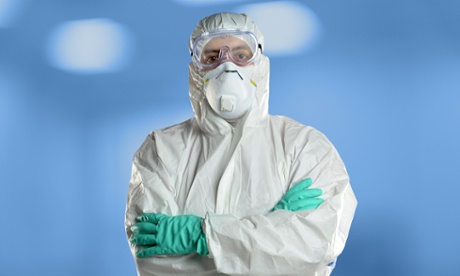- Nurses’ groups and others had called for revised advice
- Stricter CDC guidance provides ‘extra margin of safety’

Federal health officials issued new guidelines to promote head-to-toe protection for health workers treating Ebola patients.
Officials have been scrambling to come up with new advice since two Dallas nurses became infected while caring for the first person diagnosed with the virus in the United States.
The new guidelines issued on Monday set a firmer standard, calling for full-body garb and hoods that protect workers’ necks; setting rigorous rules for removal of equipment and disinfection of gloved hands; and calling for a “site manager” to supervise the putting on and taking off of equipment.
Nurses’ groups and other hospital workers had pressed the Centers for Disease Control and Prevention (CDC) for the new guidance, saying the old advice was confusing and inadequate, and workers felt unprepared.
It is not clear exactly how or when the two nurses at Texas Health Presbyterian hospital became infected. Hospital officials have said they were following CDC guidance while caring for Thomas Eric Duncan, who had travelled to Dallas from his native Liberia, one of the west African countries hit hardest by the Ebola outbreak which has killed more than 4,500 people.
“The bottom line is the guidelines didn’t work for that hospital,” said the CDC director, Dr Tom Frieden, in announcing the revision.
He said the latest advice offers an “extra margin of safety” and is better suited to US hospitals where more high-risk procedures may be used. Earlier CDC guidelines had been based on treatment of Ebola patients in Africa, which sometimes has occurred in medical tents. That advice also allowed hospitals some flexibility with wearing protective garb when dealing with a suspected – not confirmed – case of Ebola.
The CDC cannot require hospitals to follow the guidance; it is merely official advice. But these are the rules hospitals are following as they face the possibility of encountering patients with a deadly infectious disease that a few months ago had never been seen in the US.
Duncan was the first person diagnosed with Ebola in the US. The Liberian came down with Ebola symptoms last month, a few days after arriving in Dallas from Liberia.
Duncan went to Texas Health Presbyterian hospital on 25 September but was not tested for, or diagnosed with, Ebola. He was admitted a few days later, and died 8 October.
Duncan’s case led to the monitoring of about 50 people who came in contact with him before his second trip to the hospital, and dozens of healthcare workers who cared for him after his admission.
